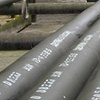-
The relationship between the deformation temperature and the amount of deformation and the hardness of the wear-resistant steel tube after recrystallization annealing was studied by electron backscatter diffraction, hardness test, tensile test and scanning electron microscope analysis. Combining with metallographic and scanning electron microscopy, The effect of deformation degree on the homogenization process, microstructure homogeneity, recrystallization and properties of alloying elements in wear-resistant steel pipe was studied. The growth behavior of the holes in the process of deformation was also simulated.
Due to the non-uniform deformation between the grains, the equivalent plastic strain at the large-angle grain boundaries is larger than the equivalent plastic strain in a single grain, and the phenomenon that the post-diffusion of the wear-resistant steel pipe is accelerated from the grain boundary diffusion is verified experimentally and the theory Explanation. After the deformation of the high temperature diffusion, the first coarse and fine grain Cr alloy diffusion even dual annealing data, the greater the amount of deformation, the higher the degree of recrystallization of the alloy to improve and improve the wear-resistant steel pipe structure and performance. Under the same holding time, the segregation ratio of Cr and Mo decreases, and the fine grain boundaries increase the bulk diffusion of Cr. When the deformation is 75%, the strength of the alloy is the highest, which can promote the recrystallization of Al-Si alloy, And the recrystallized grains are roughened. After 0.5 h solution treatment at 500 ℃, the wear-resistant composite pipe is deformed rapidly at a faster speed, the recrystallized grain size becomes larger after annealing, and the larger the deformation amount is, the smaller the segregation ratio is. Deformation and recrystallization based on the role of grain refinement, deformation can greatly shorten the wear-resistant steel tube dendrite removal time required for the deformation of 60%, intergranular corrosion and exfoliation corrosion sensitivity is minimal, is now mesh-like crystal Ferrite, mechanical properties decreased.
After the elastic precursor wave, the sliding and deformation between the grain boundaries dominated the pre-plastic deformation mechanism. When the degree of deformation of the alloy was 75%, the pores grew easily along the large-angle grain boundaries and the recrystallized grains decreased significantly , Wear-resistant steel pipe the best overall performance.
-
Crack characteristics and formation conditions: often occurs in the hardened parts, carbide and ribbons in the raw materials of serious segregation or non-inclusions longitudinally extending from the surface inward cracking, deep and long crack.
Solutions and preventive measures:
Elimination of carbide ribbons and segregation of raw materials, non-compliance of impurities;
Reasonable development of heat treatment process parameters;
Try to exclude human factors.
-
A surface heat treatment process that quenches only the surface of steel workpieces. The purpose is to improve the surface hardness, wear resistance and fatigue strength, while the heart still has a high toughness. Commonly used in shaft, gear and other parts. The use of rapid heating method to make the workpiece surface austenite, and then immediately quenched the surface tissue into martensite, heart tissue remains unchanged. After the surface quenching generally low temperature tempering. According to different heating methods, can be divided into induction heating surface hardening, flame heating surface hardening, electrical contact surface heating quenching, electrolyte heating surface hardening, the former two methods are the most widely used.
Heating energy is usually electromagnetic induction heating, flame heating, electrical contact heating and heating in the electrolyte; and can use more high-energy, such as electron beam, laser, electric arc. The higher the energy density provided by the energy, the thinner the surface is heated and hardened.
Electromagnetic induction heating surface hardening
Flame heating surface hardening
Electrical contact heating surface hardening
Electrolyte heating surface hardening
-
The difference between seamless steel pipe and fake seamless steel pipe, fake seamless steel pipe is welded pipe, after grinding hot work can not see the weld. There are several common market pipe, straight seam welded pipe, spiral welded pipe and seamless pipe, but the longitudinal welded pipe and spiral welded pipe are very well recognized, seamless pipe and seamless steel pipe can be distinguished from the following aspects look:
1, The pipe is generally fixed length, and are generally 6 meters, 9 meters or 12 meters. Seamless steel pipe length is very small, because the factory price increase is very much.
2, It can be seen from the cross-section of the pipe head, if rust, then wipe him earn, look carefully, then you will find the welding area.
3, If you use pickling, the effect is most obvious.
4, Check the wall thickness, seamless wall thickness is not uniform, fake seamless steel pipe wall thickness is even.
-
Billet perforation temperature based on the same raw materials and something different. However, most of the thermal expansion welded pipe is about 1200 ℃, the temperature is slightly lower when the carbon content and other alloy elements are more.
The second key to heating is to minimize the amount of scale. Especially in hot kneading the elbow, thermal expansion pipe from the east-west life and kneading the surface quality of the pipe to go, implore more severe.
In the spiral pipe production process, because the primary processing is carried out in the hot state, the heating operation is to determine the quality of the product is very important process.
Heating stoves, according to their effect, are divided into heating furnace and reheating furnace; the former is used to heat the billet from normal temperature to processing temperature; the latter is used to reheat the billet to the necessary processing temperature.
Improper heating will become the tube surface or external surface may appear on the surface cracks, folding and partial waste and other causes of waste.


























